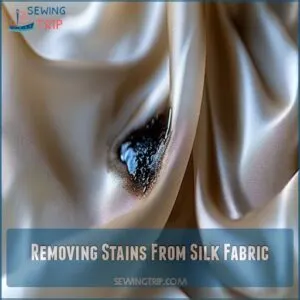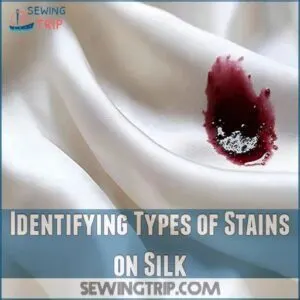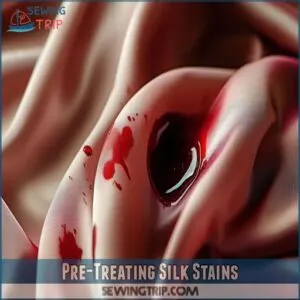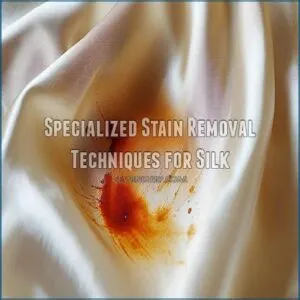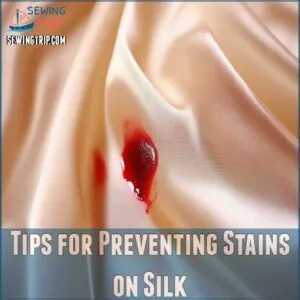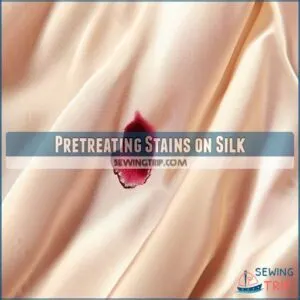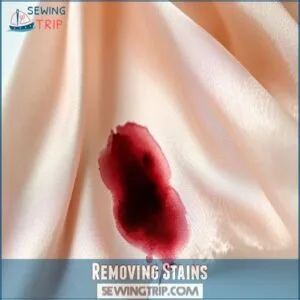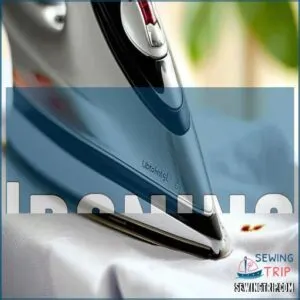This site is supported by our readers. We may earn a commission, at no cost to you, if you purchase through links.
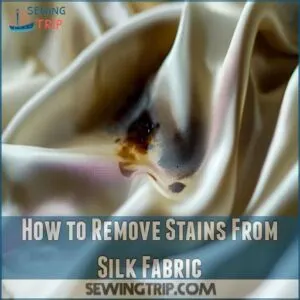 Don’t panic when you spot that red wine splash on your favorite silk blouse – you’ve got this!
Don’t panic when you spot that red wine splash on your favorite silk blouse – you’ve got this!
To remove stains from silk fabric effectively, start by gently blotting (never rubbing!) the stain with a clean white cloth.
Mix one part gentle dish soap with two parts cool water, then test this solution on an inconspicuous area first.
Dab the stain carefully with the mixture using a cotton swab, working from the outside toward the center.
Rinse thoroughly with cool water and air dry.
For those tricky oil marks or stubborn makeup stains, there’s a secret weapon that professional cleaners swear by.
Table Of Contents
- Key Takeaways
- Removing Stains From Silk Fabric
- How to Remove Stains From Silk Fabric
- Identifying Types of Stains on Silk
- Pre-treating Silk Stains
- Specialized Stain Removal Techniques for Silk
- Tips for Preventing Stains on Silk
- Silk: a Durable Yet Delicate Fabric
- Pretreating Stains on Silk
- Step-by-Step Stain Removal for Silk
- Do’s and Don’ts of Silk Care
- Frequently Asked Questions (FAQs)
- Conclusion
Key Takeaways
- Act fast when a stain occurs – blot (don’t rub) with a clean white cloth to prevent the stain from setting into the silk fibers
- Use a gentle cleaning solution of mild dish soap and cool water, testing it first on an inconspicuous area before treating the main stain
- Choose your cleaning method based on the stain type – use cornstarch for oil, white vinegar solution for wine, and lukewarm water with mild detergent for food stains
- Let your silk air dry naturally away from direct sunlight, and never use harsh chemicals or hot water that can damage the delicate fibers
Removing Stains From Silk Fabric
When you’re battling stubborn stains on your favorite silk blouse, quick action is your best friend.
Don’t worry – with the right tips, you can tackle those spots and keep your silk looking fabulous.
Quick Tips for Silk Stain Removal
Right after a silk mishap, act fast! Here’s your arsenal of speedy solutions:
- Blot, don’t rub!
- Use cool water.
- Try natural remedies like vinegar.
- Air dry, away from the sun.
- For tough stains, consider professional help.
These simple steps can save your favorite silk pieces. Preventative care is key!
Avoiding Common Mistakes in Silk Stain Removal
When tackling silk stains, avoid these blunders. Don’t rub; blot gently to prevent fabric damage.
Using hot water? Big no-no—silk likes it cool!
Skipping the test spot? Always check first. Incorrect detergent can spell disaster. Opt for gentle cleaning. And hey, when the stain won’t budge, consider professional dry cleaning.
| Mistake | Effect | Solution |
|---|---|---|
| Rubbing the stain | Spreads stain | Blot gently |
| Using hot water | Damages fibers | Use cool water |
| Skipping test area | Risks fabric damage | Test on hidden spot |
| Wrong detergent | Can ruin silk | Choose mild, gentle detergent |
How to Remove Stains From Silk Fabric

Removing stains from silk fabric can feel tricky, especially given its smooth, soft, sensuous texture against the skin, which is due in part to its genuine silk properties. Removing stains from silk fabric can feel tricky, but with a few smart moves, you’re in control. Here’s a quick guide to help you tackle stubborn spots.
- Blot It: Quickly blot the stain with a clean cloth. This helps prevent it from setting.
- Mild Detergent Magic: Make a gentle solution with mild detergent and lukewarm water. Dab, don’t rub. It’s also essential to check the care label for specific guidance on washing silk garments, as some may require dry cleaning.
- Vinegar Boost: For tough spots, try mixing a bit of white vinegar with your solution.
- Rinse Right: Gently rinse with cool water to wash away any residue.
- Air Dry: Lay the silk flat to dry. Avoid direct sunlight to keep colors vibrant.
When working with delicate fabrics like satin, it’s essential to understand the properties and potential risks of certain cleaning methods, such as bleaching satin can you bleach satin how to. These silk stain removal tips combine DIY solutions with thoughtful fabric care. Let your silk shine again!
Identifying Types of Stains on Silk
Silk stains aren’t all created equal, and knowing what’s what can save your favorite blouse. With a keen eye, you can tackle oil, wine, makeup, water, and food stains effectively.
Oil Stains
Imagine this: you’re enjoying a greasy snack, and bam, an oil stain lands on your silk!
Don’t panic.
Grab some cornstarch or talcum powder—your oil stain home remedy heroes.
Sprinkle it on, let it sit, and gently brush off.
These oil stain treatments soak up the mess without harsh chemicals.
Remember, patience is key to oil stain removal success.
Wine Stains
If you thought oil stains were tricky, red wine stains can be a nightmare on silk.
Removing silk stains requires Quick Treatment for Silk Stains to minimize damage and discoloration.
Quickly blot the stain with a clean cloth—don’t let it settle.
Mix lukewarm water and white vinegar, gently dabbing onto the stained area.
Avoid rubbing to keep the stain contained.
For white wine stains, this technique works wonders too!
Makeup Stains
Got a bit of lipstick or mascara on your silk? Don’t sweat it.
To tackle those pesky foundation or concealer stains, follow these easy steps:
- Blot carefully with a soft, white cloth to lift excess.
- Dab gently with a mild detergent.
- Rinse with cool water, ensuring no residue.
- Pat dry and let air naturally.
Water Stains
Water stains—a silk owner’s nemesis! But don’t panic. Quick action is key to preventing water stain damage. Here’s a handy guide to water stain removal on your precious silk:
| Water Stain Type | Prevention Tips | Removal Steps | Success Rate |
|---|---|---|---|
| Light water rings | Air dry thoroughly; avoid direct sunlight | Blot gently with a clean cloth; air dry. | High |
| Heavy water marks | Prevent spills; use a fabric protector spray | Blot; use a vinegar/water solution (test first!) | Medium |
| Set-in water damage | Careful handling; protect from rain and spills | Professional cleaning recommended | Low |
| Hard water spots | Use filtered water when cleaning | Gently blot; use distilled water; air dry. | Medium |
Remember, preventing water stains is easier than dealing with them!
Food Stains
So, moving from those pesky water rings, let’s tackle food stains on silk.
Here’s how you can manage them:
- Blot gently with a clean cloth to soak up excess.
- Mix lukewarm water with mild detergent for a cleaning solution.
- Dab carefully without rubbing to avoid damage.
- Rinse with cold water and air dry.
Stay calm and silk on!
Pre-treating Silk Stains
When life throws a stain at your beautiful silk, don’t despair—quick, careful pre-treatment is your friend.
Blot away excess liquid, gently apply mild detergent, and rinse with cool water for best results.
Blotting Excess Liquid
Imagine this: You spill grape juice on your silk tie. Don’t panic! Swiftly grab a tissue or clean cloth. Gently blot the stain with gentle pressure. Avoid rubbing–you wouldn’t want to massage the mess further. This simple trick of excess liquid removal can save the day and prevent spreading. Keep calm and blot smartly!
| Step | Approach | Tool Needed |
|---|---|---|
| Blotting | Gentle pressure | Tissue/Cloth |
| Objective | Excess liquid removal | None |
| Key Point | Prevent spreading | None |
| Action | Swift blotting | None |
| Benefit | Stain minimized | None |
Applying Mild Detergent
After blotting the stain, you’ll want to apply a mild detergent, but don’t just douse it.
Grab your choice of gentle detergent and dilute it with water.
Think of this solution as your secret weapon against those stubborn stains.
Gently dab the mixture onto the silk, letting the detergent types work their magic without soaking.
Rinsing With Cool Water
Great, the mild detergent worked its magic.
Let’s rinse with cool water next.
It’s the gentle hero of stain removal techniques.
Rinse thoroughly, letting the cool water carry away the detergent and loosened stain.
Think of it as a revitalizing splash for your silk, preserving its beauty.
Remember, gentle washing methods help your silk fabric stay vibrant and intact.
Specialized Stain Removal Techniques for Silk
Now that you’ve pre-treated those pesky stains, let’s tackle some specialized techniques for silk.
We’ll cover specific methods for oil, wine, makeup, water, and food stains, ensuring your silk stays looking its best!
Removing Oil Stains
Dealing with oil stains on silk? Fear not! Here’s your go-to guide:
- Sprinkle talcum powder: Cover the stain to soak up oil.
- Let it sit: Give it about 30 minutes to work its magic.
- Brush away: Gently remove the powder.
- Use mild detergent: Dab gently with lukewarm water for stubborn spots.
Keep it gentle and effective!
Removing Wine Stains
Wine stain removal on silk can feel like taming a stubborn lion.
Quickly blot the stain with a clean cloth—don’t let it sit.
For tougher stains, consider the blotting technique for delicate fabrics like viscose stain removal methods.
Red wine calls for a mix of white vinegar and water.
Dab, don’t rub!
For white wine, simply dilute with water.
If stains linger, opt for professional cleaning.
Alternative methods might backfire, so proceed with care!
Removing Makeup Stains
Makeup stains on silk can feel like a nightmare, but don’t fret! Gently dab the stain with a mild detergent solution.
For tougher smudges, try specialized makeup stain removers.
Remember, rubbing can make it worse. Test a hidden spot first to avoid surprises. Always rinse well afterwards.
Keep those delicate silks pristine by storing makeup removal products nearby—your trusty defense against those sneaky smudges!
Removing Water Stains
You’ve got water spots on silk, huh? Don’t fret! Tackle these sneaky stains with ease:
- Gently rub with a white towel.
- Use a clean silk cloth to absorb any leftover water.
- Air dry in shade, avoiding direct sunlight.
- Skip harsh chemicals to keep silk safe.
- Rubbing lightly is your friend here.
Removing Food Stains
Got a food stain on silk? Don’t panic!
Blot gently with a clean cloth, then dab the stain with lukewarm water and mild detergent.
Remember, rubbing is a no-go—nobody wants to ruin those delicate fibers!
Rinse with cold water, and if all else fails, professional help can be your silk savior.
Prevention is easier than curing, so be cautious next time!
Tips for Preventing Stains on Silk
To keep your silk looking its best, there are a few habits you can adopt to prevent stains.
Avoid snacking while wearing it.
Spray on a fabric protector.
Store it safely to minimize mishaps.
Avoiding Eating or Drinking
Mastering silk care? Let’s talk eating etiquette. Spills happen, right? So, here’s how to avoid a silk-staining disaster:
- Keep food and drinks away from your silk clothes.
- Practice mindful dining; eat slowly and carefully.
- If you must eat while wearing silk, use napkins diligently.
Silk protection starts with you!
Applying Fabric Protector Spray
Think of fabric protector spray as a shield for your silk.
Applying it’s straightforward: choose the best brand, follow proper spraying techniques, and you’re set.
Whether enjoying store-bought brands or DIY options, you’ll find various fabric protector types to extend protection duration.
Here’s a quick comparison:
| Feature | Examples |
|---|---|
| Fabric Protector Types | Store-bought, DIY |
| Spraying Techniques | Light, Even |
| Best Brands | Scotchgard, Apple |
Storing Silk Garments Properly
Imagine this: silk garments that look as beautiful as the day you got them. Achieve this by:
Using padded hangers to prevent those pesky shoulder bumps.
Storing in breathable fabric bags to keep moisture at bay.
And remember, if you ever encounter a stain on your silk, be sure to check out a trusted online retailer for silk stain cleaners – they’ve got you covered!
Keeping your silk in a cool, dry place protects it from moth damage and climate changes.
These silk storage tips help your treasures last.
Handling Silk Garments With Care
You’ve got silk, so handle it with care, just like a prized collector’s item. Here’s a quick guide:
| Action | Why |
|---|---|
| Wash gently | Prevents fiber wear, use lukewarm water. |
| Iron lightly | Avoid harsh settings; try a cool iron. |
| Repair tears | Patch small tears promptly to avoid rips. |
Keep it pristine, your silk’s secret to longevity.
Silk: a Durable Yet Delicate Fabric
Silk may feel like the superhero of fabrics with its strength, but it needs gentle care.
Treat it kindly by avoiding harsh chemicals.
You’ll enjoy its beauty for years to come.
Understanding Silk Fibers
Understanding silk fibers starts with appreciating their blend of strength and elegance.
Silk has a storied past, praised for its luxury and durability.
Here’s the scoop:
- Silk properties give it a natural sheen, enhancing its beauty.
- Despite its history, it requires gentle care.
- Different silk types require varying attention, but all promise lasting beauty if treated well.
Avoiding Harsh Chemicals
Silk is like a delicate flower that reacts poorly to harsh chemicals.
For tough stains like those on nylon, try a two-pronged approach by both blotting and scraping oil stains. Opt for natural stain removers or gentle cleaning solutions to keep it safe.
You can find a variety of natural silk stain removal products to help you care for your silk garments.
Silk’s natural properties, such as containing natural moisturizers and antimicrobial properties, make it a great fabric to work with. DIY silk stain removal with eco-friendly silk care products guarantees no harm to the fabric.
When choosing products, think of your silk as a finely tuned instrument needing the right touch.
Proper Care for Silk Garments
So, you’ve avoided harsh chemicals—great job! Now, let’s talk about keeping your silk looking its best. Proper silk garment care is key.
Before we get into storage and cleaning tips, remember to always perform a colorfastness test before attempting to remove any stains.
Here’s how:
- Store silk in a cool, dry place, away from direct sunlight. Regular cleaning and maintenance, such as gently washing silk flowers with soapy water and blow-drying them afterward, prevent silk from fading in the sun. This prevents fading and damage.
- Always hand-wash or opt for dry cleaning. Avoid harsh soaps or fabric softeners.
- Ironing silk? Use a low setting and a pressing cloth to prevent scorching. Easy peasy!
Pretreating Stains on Silk
Pretreating stains on silk is like a superhero swooping in to save the day—quick action makes all the difference.
Pretreating stains on silk is like a superhero swooping in to save the day—quick action makes all the difference.
Grab a clean cloth and dab the stain gently to keep it from setting and limiting damage.
Minimizing Stain Damage
Think of silk as an elegant dance partner—gentle moves keep the partnership thriving.
When a mishap happens, act swiftly.
Start with blotting; it’s like dabbing spilled tea, gentle yet firm.
This prevents stains from settling.
Remember, less pressure is more protective!
Treat silk with careful hands, fostering its delicate beauty and ensuring it rebounds gracefully from life’s little spills.
Prompt Action for Successful Removal
When you spot a stain on your silk, treat it like a ticking clock – every second counts.
By acting fast, you’ll prevent the stain from setting deep into the fibers.
For tough stains like oil or grease, using a Quick Treatment for Silk Stains can make all the difference.
Grab a clean white cloth and gently blot (don’t rub!) to soak up any excess liquid.
This quick response will make the full cleaning process much easier and boost your chances of complete stain removal.
Step-by-Step Stain Removal for Silk
Pretreating stains sets you up for success, but now let’s walk through the actual stain removal process. Treating silk stains is like performing a delicate dance – each move matters.
Here’s your simple roadmap to stain-free silk:
- Mix a teaspoon of mild detergent with two cups of lukewarm water in a clean bowl.
- Dip a white cloth into the solution and gently press it onto the stain’s edges, working your way inward.
- Let the solution sit for 3-5 minutes, then rinse with cool water.
I once ruined my favorite silk scarf by rushing this process, but patience really pays off here. Blot the treated area with a dry white cloth, and repeat if needed.
For stubborn stains that won’t budge, you might need professional help – but we’ll get to that later.
Do’s and Don’ts of Silk Care
You’ll save yourself a lot of headaches when you know the right way to handle those pesky silk stains, from quick blotting to gentle cleaning methods.
While caring for silk might seem tricky at first, you’ll find it’s actually quite simple once you learn the basic do’s and don’ts of stain removal.
Removing Stains
Dealing with silk stains requires a gentle touch and quick action.
You’ll want to blot – never rub – the affected area with a clean white cloth.
For oil stains, sprinkle cornstarch or talcum powder and let it sit overnight.
With water-based stains, mix equal parts white vinegar and water, then dab gently.
Always test cleaning solutions on a hidden spot first.
Washing
Now that you’ve tackled those pesky stains, let’s keep your silk looking pristine with proper washing techniques.
Always check the care label first – some silks are dry clean only.
For hand washing, use lukewarm water and a gentle detergent made for delicates.
If machine washing is allowed, place your silk in a mesh bag and use the delicate cycle with cold water.
Drying
After treating stains, air drying your silk pieces properly is essential for their longevity.
Never wring or twist silk to speed up drying – you’ll just end up with wrinkles and damage.
Instead, lay your silk flat between clean white towels and gently press out excess moisture.
Keep it away from direct sunlight to prevent fading, and hang delicate pieces on padded hangers for best results.
Ironing
Like a delicate dance between heat and fabric, ironing silk requires precision.
Set your iron to the lowest silk setting and always use a pressing cloth to protect the fabric.
Don’t press directly on embellishments or stains.
For stubborn wrinkles, use light steam but keep the iron moving.
Iron the silk while slightly damp, and work on the garment’s reverse side for best results.
Frequently Asked Questions (FAQs)
How do you get stains out of silk?
Swiftly soak silk stains by blotting gently with mild detergent and cool water.
Avoid rubbing – you’ll spread the stain.
For tough spots, sprinkle cornstarch on oils or dab white vinegar on wine marks.
How do you remove discoloration from silk?
To remove silk discoloration, mix equal parts white vinegar and water, then gently dab the affected area.
For stubborn spots, try a specialized silk cleaner.
Always test solutions on a hidden spot first.
How to remove sweat stains from silk?
Gently dab sweat stains with a mixture of equal parts white vinegar and water.
You’ll want to blot the area with a clean cloth, then let it air dry.
Don’t rub or you’ll damage the silk.
What happens if you remove a stain from silk?
When you remove a stain from silk, you’ll find the fabric’s delicate fibers respond well if treated carefully.
However, rushing the process can damage or discolor your garment, so follow the care instructions thoroughly.
How do you remove food stains from silk?
Blot excess food quickly with a clean cloth.
Avoid rubbing – you’ll just spread the mess.
Mix mild detergent with lukewarm water, dab the stain, and rinse with cold water.
Let it air dry.
How do you clean a silk garment?
Hand-wash your silk in cool water with mild detergent.
Air dry away from direct sunlight.
You’ll want to press out excess water gently between towels – don’t wring or twist.
Can stains on silk be removed?
Most stains can be removed from silk if you act quickly.
You’ll need to blot the area gently with a clean cloth.
Use specific treatments based on the stain type – oil, wine, or water-based.
Does vinegar damage silk?
Like a gentle caress, diluted white vinegar won’t harm your silk when used properly.
You’ll want to mix it equally with water and test it first on a hidden spot before treating stains.
Can hydrogen peroxide remove stains on silk?
Don’t use hydrogen peroxide on silk – it’s too harsh and will damage the delicate fibers.
You’re better off sticking with gentle solutions like diluted white vinegar or seeking professional dry cleaning services.
How can I clean silk fabric?
Treating silk is like performing a delicate dance.
Hand-wash in cool water with mild detergent.
Gently squeeze (don’t wring).
Lay flat between towels and air dry away from direct sunlight.
Skip the dryer.
Can sunlight help remove yellowing stains from silk?
Sunlight won’t help with yellowing silk – it’ll actually make things worse.
You’re better off using a gentle white vinegar solution or seeking professional cleaning to protect your delicate silk fabrics.
How long should silk air dry after stain treatment?
Let your silk air dry completely for 4-6 hours at room temperature.
You’ll know it’s ready when the fabric feels dry to the touch.
Never rush drying with heat or direct sunlight.
Do silk stain removers expire or lose effectiveness?
Most stain removers, especially those designed to tackle stubborn stains like green tea stain clothes found on silk fabrics via the tannin content guide, will maintain effectiveness for 1-2 years when stored properly.
You’ll notice they’re less effective if they’ve changed color, separated, or developed an odd smell.
Always check expiration dates before use.
Can baking soda damage colored silk while removing stains?
Baking soda can weaken colored silk’s dyes and damage its delicate fibers.
You’re better off using gentle, silk-specific cleaners or white vinegar solutions that won’t compromise your fabric’s vibrancy and integrity.
Should silk be steamed before or after stain treatment?
Want to keep your silk looking pristine?
Never steam silk before treating stains – it’ll set them deeper into the fabric.
After successful stain removal, you can steam the garment to restore its smoothness.
Conclusion
Mastering how to remove stains from silk fabric might feel like defusing a bomb at first, but you’ve got this!
Armed with these techniques, you’ll tackle those dreaded spots like a pro.
Remember: quick action, gentle blotting, and the right cleaning solutions are your best friends.
Don’t let fear of stains keep you from enjoying your favorite silk pieces.
With proper care and these handy tips, you’ll keep your silks looking pristine for years to come.

